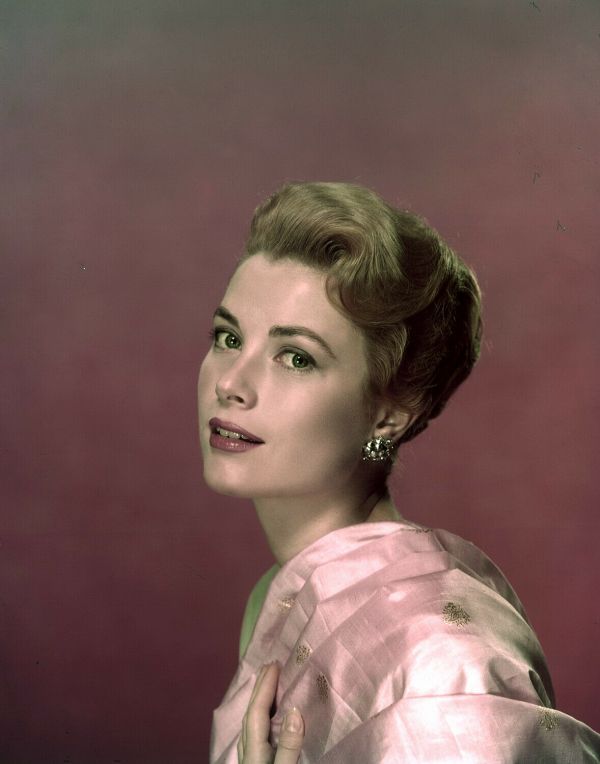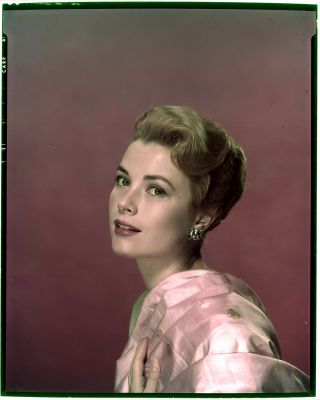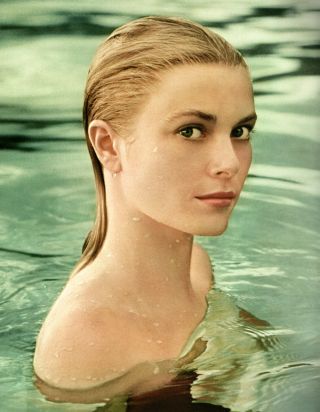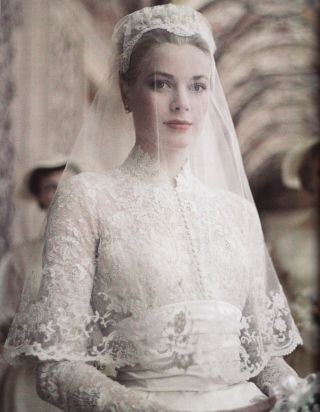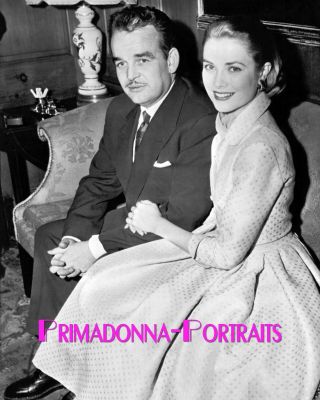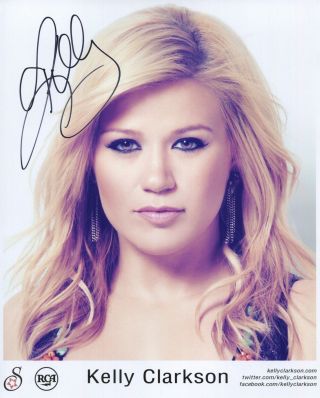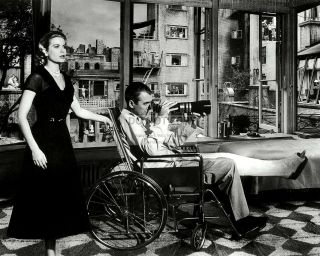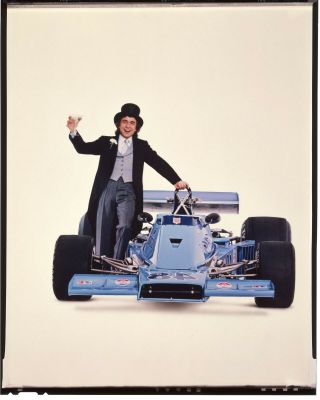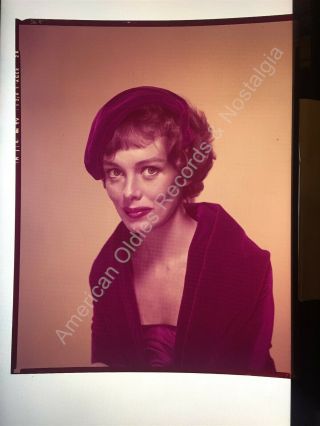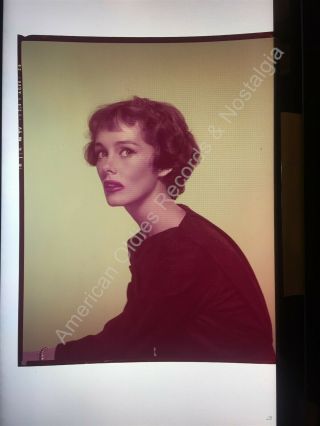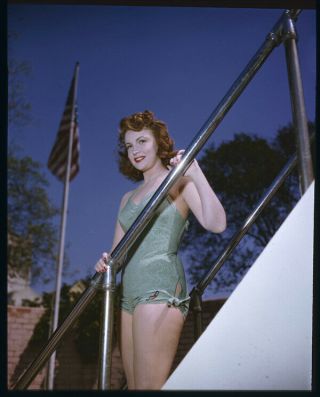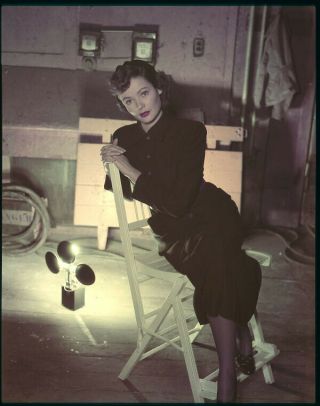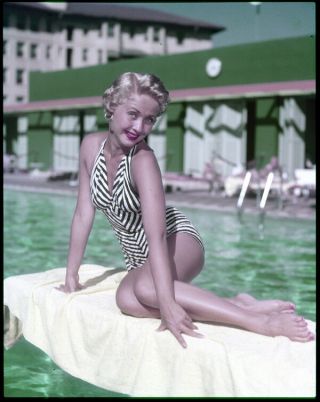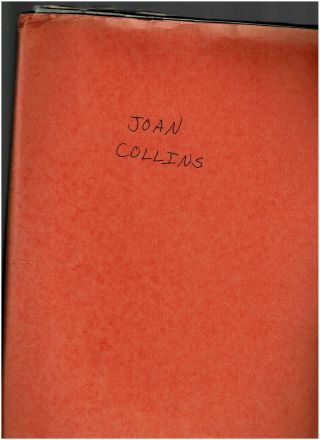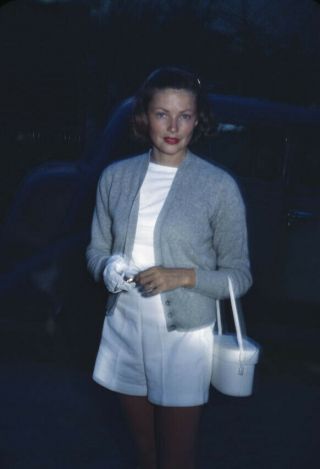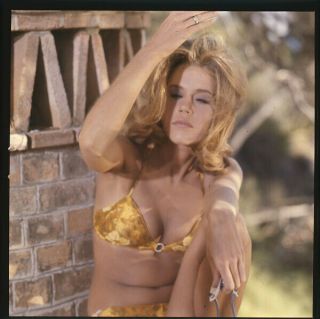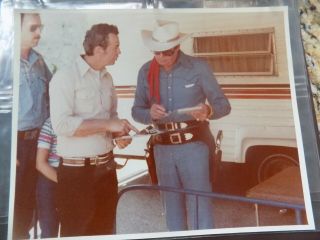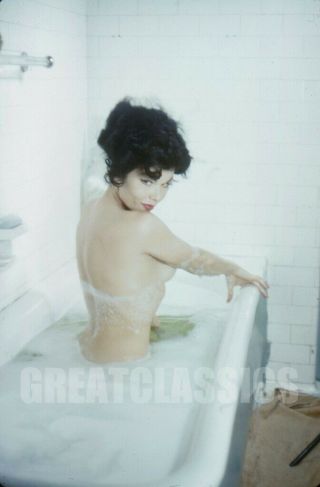Grace Kelly 1956 Eric Carpenter 8x10 Color Transparency High Society
Item History & Price
Grace Kelly rose to fame as a leading Hollywood actre...ss following her prominent role in "High Noon". Along with her Academy Award-winning performance in "The Country Girl", she starred in the Alfred Hitchcock films "Rear Window", "Dial M for Murder" and "To Catch a Thief". Kelly left Hollywood behind after marrying Prince Rainier III of Monaco in 1956, thereby becoming known as Princess Grace. She died in her adopted home country in 1982, following a car accident.
PLEASE NOTE: This auction is for the Ektachrome transparency only. There are no copyright or reproduction rights included in the final sale.
Guaranteed to be 100% vintage and original from Grapefruit Moon Gallery.
More about Grace Kelly:
In the storied history of the American cinema, few stars shone so brightly for so briefly as Grace Kelly. A working actor for just five short years in the 1950s, known best for her roles as sparkling, whimsical socialites and her work in multiple Alfred Hitchcock thrillers, Kelly outwardly came to embody her name with a seemingly effortless elegance and an almost pristine aesthetic, even as behind the scenes she became notorious for her serial conquests of her leading men and other luminaries. Her talents rivaled her beauty, winning her a best actress Oscar playing against type and her own aristocratic pedigree in "The Country Girl" in 1954. But at the height of her career, Kelly cemented an idyllic legacy by bowing out of Hollywood to marry into European royalty, becoming an American fairy tale incarnate, "Princess Grace" - biographer Robert Lacey called the wedding "the first modern event to generate media overkill" - though she hardly lived happily ever after.
Kelly's storybook ascent to a princess's life did not quite involve a rags-to-riches story. Born in Philadelphia, PA on Nov. 12, 1929, Grace Patricia Kelly came up in the rarified air of Philly high society. Her father, Jack Kelly, a three-time Olympic gold medal-winner in rowing, built his modest trade as a bricklayer into a successful construction company that did work up and down the Atlantic corridor. He leveraged his success and notoriety into politics, getting elected as city councilman, running unsuccessfully for mayor of Philadelphia, and, as he maintained his athletic zeal through most his life, later being appointed National Director of Physical Fitness by President Franklin Roosevelt. Kelly's health-inclined lifestyle made him a seemingly ideal fit with his wife, Margaret, a handsome, outgoing Germanic woman. She held a degree in physical education and went on to become the first woman to coach the University of Pennsylvania's women's swim team, and later, the first director of its physical education department.
Kelly idolized her father, but, for the often sickly, clumsy child, winning the approval of such a man would prove daunting, especially with sister Peggy, the oldest, brightest and most graceful, as well as athletic older brother Kell absorbing much of Jack Kelly's considerable, disciplinarian dotage. With the arrival of baby sister Lizanne, the future star became the most solitary and detached of the Kelly clan, escaping into realms of imagination with her dolls and developing a friendship with her bohemian, "black sheep" uncle, Pulitzer Prize-winning playwright, George Kelly. She grew up "competing for love, " she would later recall, and it was not just with her siblings; Her varied biographers concur, that her father took conspicuous advantage of his own pseudo-celebrity to engage in numerous, barely-secreted extracurricular dalliances. Young Grace's penchant for make-believe further developed in school pageants, and after attending a performance by a local theater troupe, the Old Academy Players, she announced to Jack that she wanted to act. This did not sit well in her father's proper nouveau riche world, where "show folk" were looked down upon, but he grudgingly allowed her to join the theater. She made her first professional stage appearance at age 12 in a play called "Don't Feed the Animals, " remembering the experience as "nice to feel an audience respond." As she flowered from gawky girl into a stunning teen, Grace Kelly had finally found a source of the validation she did not receive in the Kelly household.
But where she veered into the unseemly world of the arts, Kelly would dutifully adhere to Jack's ethos in another way: amorous liaisons. The Kelly patriarch would not brook the "wrong type" for his daughters, and made no bones about vetoing relationships. He did just this when Grace's first boyfriend, Harper Davis, graduated high school in 1944 and joined the Navy. Jack looked down on the boy because his family was Protestant and his father a mere Buick dealer, insisting his daughter end the relationship before Davis was shipping-off-to-war. After dumping Davis, per her father's encouragement, she settled into a dating pattern more characterized by volume and whimsy; not unlike his sexual proclivities. Her dichotomous path of pseudo-rebellion and pursuit of paternal approbation would continue upon her own graduation in 1947.
Rejected by prestigious Bennington College for her sub-par grades, her uncle George's good name got her an audition and acceptance at the American Academy of Dramatic Arts in New York - to her father's chagrin. In ensuing years, she honed her craft and image, putting emphatic work into the refined, Anglicized accent that would be the hallmark of her later screen personae; became a prolific model for print advertising; and began a series of romances with older, high-profile men. Among them were French movie actor Alex D'arcy, the Shah Reza Pahlavi of Iran (whose marriage proposal she turned down) and up-and-coming Broadway director Don Richardson, also one of Kelly's teachers. The ongoing Richardson relationship, however, outraged her parents, as he was still married (though in the process of securing a divorce) and - more unforgivable in the Kellys' elite circles - he was Jewish. Jack Kelly, Richardson said later, would go so far as to attempt to bribe him into ending the relationship, and, when that did not work, Richardson received threatening calls from brother Kell.
Kelly made her Broadway debut in 1949 in August Strindberg's "The Father, " and while she received favorable notices, it became clear she lacked the booming projection required for live stage performances. The young medium of television, however, proved less demanding. Kelly became a regular in the many live teleplays the networks aired in their early days, appearing on 60 broadcasts between 1950 and 1953, in addition to building her theater bona fides with summer stock productions. In the meantime, her agent had secured her an audition with Stanley Kramer for his upcoming western, the now-classic "High Noon" (1951). As a relative unknown in Hollywood, Kelly's price was right for Kramer's limited budget, and after her stoic presence in the interview, director Fred Zinnemann decided she would be perfect for the role of repressed, pacifist wife of Gary Cooper's world-weary marshal. She would castigate herself for her own performance for years after, but, according to biographer Wendy Leigh, the experience was highlighted by the first of what would become a pattern for her - a quiet affair with her leading man, the 50-year-old Cooper. Leigh also alleged Kelly engaged in a concurrent romance with Zinnemann.
The pattern would manifest on her very next film project, with another venerable movie great. She renewed her studies, now with New York drama guru Sanford Meisner, but "High Noon" became a hit, winning Cooper a Best Actor Oscar and netting more Hollywood attentions, including that of directorial legend John Ford. Ford was then casting the Africa-set adventure "Mogambo" (1953), a remake of "Red Dust" (1932), starring Clark Gable and Ava Gardner. Signing onto the project, Kelly became an MGM contract player, earning $30, 000 a year, with accessions to her demands that she could still live in New York, do no more than three films a year, and continue her stage work. For the movie, the studio granted her third billing after its own stars, Gable and Gardner. Shooting in Kenya, Kelly learned Swahili, quickly fell into a relationship with Gable - 28 years her senior and four times married and divorced (once widowed) - and mirrored her screen role, a repressed and proper young woman awakened to the world by the majesty and danger of Africa and by the roguish Gable. At the end of the shoot, the actors went to London, where they discovered the media already abuzz over their short-lived romance. Kelly had become tabloid-fodder, on top of which, "Mogambo" would earn her an Oscar nomination for Best Supporting Actress. It also earned her a call from Alfred Hitchcock.
Hitchcock, notorious for the prim but ravishing Nordic female leads in his sometimes dark, sometimes quirky thrillers, gave Kelly the lead in "Dial M for Murder" (1954), the first of their three films together. Playing the target of her scheming husband's (Ray Milland) intricate murder plot, she went from demure to somewhat risqué violence on-screen, effecting Hitchcock's vision of a "snow-covered volcano" for the role. Off-screen, she erupted in another way. Her own prim, sometimes icy demeanor belied a series of sexual conquests of principals on the film, including co-star Tony Dawson, writer Frederick Knott and, as one might expect, Milland. "She f*cked everyone!" Hitchcock later told screenwriter Bryan Mawr. The affair with Milland - again, a much older man - became the most serious, in more ways than one. It threatened to boil into a scandal, given that his bride of 30 years had enjoyed her status as one of the most popular Hollywood wives in the city. Kelly later insisted that Milland had misrepresented the marriage as troubled. While bedroom canoodling may have been as rampant in 1950s Tinseltown as today, the studio system abhorred public scandals as threats to box-office receipts, and, to avoid a potentially permanent blot on her burgeoning career, as soon as shooting finished on "Dial M, " Kelly returned to New York City.
Now an undeniable star, she next found herself facing a choice between Elia Kazan's gritty drama "On the Waterfront" (1954) opposite Marlon Brando or Hitchcock's "Rear Window" (1954). She chose to advance the growing paternal working relationship with Hitchcock, though, famously, Eva Marie Saint would win the Academy Award for the role Kelly passed on. Playing opposite Jimmy Stewart, Kelly fell into the role naturally, sparkling as the playful, affectionate and snoopy socialite Lisa Fremont, slumming as the girlfriend of Stewart's temporarily wheelchair-bound police photographer. The dazzlingly designed Hitchcock classic would be a showcase of Kelly's beauty and her true personality. "Her gift did not lie in impersonating other people, " said one biographer. "Her talent was to impersonate her fantasy of herself. She had sensed how Lisa Fremont was her own dream . . . It was the direction in which Grace was pushing her own life, mustering the bouncy self-assurance she needed to buoy her very needy inner child . . ." Well before the film's summer 1954 release, buzz developed around the rough-cuts, prompting Billy Wilkerson, editor of The Hollywood Reporter to rave, "It won't be long before this attractive kid will be the Number One Box Office attraction in the world." Just months before the "Rear Window" premiere, the prestigious LIFE magazine featured Kelly as its cover story.
Kelly wrapped 1953 in a relatively unceremonious stint, playing William Holden's wife in "The Bridges of Toko-Ri" (1954). Not surprisingly, during the process she fell in love with the married Holden (who similarly drew Jack Kelly's cold wrath upon an ill-advised visit). The movie, however, would prove a stepping stone to Grace's Academy Award, as its producer-director team of William Perlberg and George Seaton were even then plotting their next project, a film version of Clifford Odets' Broadway hit "The Country Girl." They had originally cast Jennifer Jones in the title role, but when she became pregnant, they immediately settled on Kelly. After a flare-up with MGM over her "loan-outs" to other studios, Paramount paid MGM $50, 000 for her time and she went to work, again with Holden, playing a bleak, frumpy woman mired in the despair of a failing marriage to a besotted, depressed, washed-up crooner. Holden played a director of a Broadway play, who falls for Kelly's character after casting her husband, in turn played by 50-year-old, depressed (sometimes besotted) crooner Bing Crosby - an uncomfortable love triangle that eerily mirrored real life. Crosby, whose own unhappy marriage had ended when his wife died of cancer (and who infamously shunned her for her last months of life), fell for the 24-year-old Kelly, and Holden - now seeking a diplomatic way out of his own relationship with Kelly - graciously bowed out. Crosby publicly courted her and they became an "it" couple for a time, but in the end, she turned down his marriage proposal.
After the forgettable MGM outing "Green Fire" (1954), Kelly sought another loan-out to Paramount to work again with Hitchcock. In "To Catch a Thief" (1955), she also returned to her showcase character type; a flirty, devil-may-care debutant playing with intrigue, this time with Cary Grant as her on-screen love interest. Off-screen, during filming in the south of France, she entertained the overtures of a new brand of suitor, the 41-year-old fashion designer and international playboy, Oleg Cassini. Before the end of the shoot in the idyllic setting, Cassini, enraptured as so many before, casually broached marriage and Kelly accepted. But they returned to the U.S. to find Kelly's star going nova, as Life and The Hollywood Reporter had predicted, and their relationship already the subject of professional gossipmongers. That did not sit well with Jack and Margaret Kelly, who similarly considered Cassini beneath their pedigree and, when they met, went out of their way to alienate him. The Kellys' humiliating treatment and their daughter's tacit servility to them gave Cassini ominous pause about the future would-be marriage. Journalist John Glatt later suggested Kelly may have been pregnant by Cassini but, in the wake of the imbroglio with her family, had an abortion.
At the end of 1954, "The Country Girl" opened to critical raves, and The New York Drama Critics Circle gave Kelly even more ammunition in her renewed contract dust-up with MGM, naming her their "Best Actress of 1954." It would prove a harbinger of big things to come, and not just professionally. The next March, Kelly beat out Judy Garland, Jane Wyman, Audrey Hepburn and Dorothy Dandridge for the Academy Award for Best Actress for "The Country Girl." She had asked Cassini to beg off attendance for appearances' sake and later intimated she went home alone with her Oscar - though on biography suggested a more ribald after-party, with the Best Actor winner Brando slipping her his phone number during the post-event photo op and winding up in bed with her only a few hours later. According to the Kelly biography, Crosby, hoping to rekindle things, actually walked in on the couple in flagrante delicto. If that seemed an awkward celebration to the evening, Jack Kelly's backhanded response to the news may have topped it. "Of my four children, " he told reporters, "she was the last one I'd expected to support me in my old age." But the accolade also led her to join the American delegation to the Cannes Film Festival, where in a famous photo op in the royal palace of the tiny, nearby principality of Monaco, she met its 31-year-old sovereign, Prince Rainier III. While the trip saw Kelly strike up a new relationship with France's foremost actor, Jean-Pierre Aumont, she also began a secret courtship of letters with the prince upon her return to the U.S.
Her next movie, "The Swan" (1956), would prove strangely prophetic, as it had when Kelly had starred in a teleplay version of it on CBS in 1950. In it, she plays the well-born scion who must choose between being true to herself or marrying a disinterested prince for the good of her country and family. In December 1955, Prince Rainier made a celebrated trip to the U.S., reputedly on the hunt for a princess, and while both had officially denied anything between them, his path led to the Kelly family's door in Philadelphia. After a courtly visit, he proposed. Not surprisingly, the Kelly family proved far more gracious to Rainier than to her previous beaus. The wedding was set for April 1956, and the news of the engagement swept through the media as a fairy tale come true. Grace went on to make "High Society, " MGM's extravagant, if fluffy musical remake of the Oscar winning 1940 comedy "The Philadelphia Story, " set to tunes by Cole Porter. It re-teamed Kelly with Crosby and new co-star Frank Sinatra, the husband of her friend Ava Gardner. It would be her last film, another dazzling turn as an independent-minded, sexy Kellyesque character, who sported the 12-carat diamond ring Rainier had given her in real life. It was not, reputedly, the last quality time she would spend with Sinatra.
Kelly and her entourage boarded the U.S.S. Constitution on April 4 with thousands of fans seeing her off from New York's Pier 84 and some 20, 000 Monegasques lining the streets of her future kingdom to greet her at the end of the voyage. Conspicuously, Kelly received a chilly reception from her mother-in-law-to-be, Princess Charlotte, whose entire family would soon be appalled by the media circus that engulfed their kingdom. On April 18, Kelly and Rainier married in a civil ceremony in the his palace, with a cathedral wedding the next day attended by a star-studded throng of 600 - ironically bereft of other European royalty, who considered Monaco's House of Grimaldi to be lesser royalty - and watched on television by upwards of 30 million people. Kelly officially became Grace Grimaldi, an irony given Jack Kelly's reactionary dismissal of previous "ethnic" suitors. Never one to miss a trick, MGM released "The Swan" to coincide with the event.
Kelly had dodged questions for months as to whether the marriage would end her acting career, but at length, the royal family made clear an all-too-familiar opinion that such endeavors would be beneath her station. This time, pomp, circumstance, aristocratic propriety and family obligations would enforce it. Nine months after the wedding, Princess Grace gave birth to their first child, Princess Caroline. The royal couple would have two more children, Prince Albert II, and, after a series of traumatic miscarriages, Princess Stéphanie. But the fairy tale euphoria had faded quickly. Rainier's pompous, controlling disposition assured that Kelly's Lisa Fremont essence would not have reign, and he even banned her movies from being shown in Monaco. She busied herself with her husband's appointment of her to head up Monaco's foremost charity, the Red Cross, and her elegant stamp on the principality - including luring show business friends to play Monte Carlo - helped boost the economy out of its financial straits. But Kelly was further crushed in the summer of 1960, when the man she has spent her life equal parts trying to impress as well as emulate, Jack Kelly, died of stomach cancer.
Hitchcock visited often and struck up a friendship with Rainier, who had mellowed a bit by 1962, when he acceded to his wife and Hitch's wish to cast the princess in his upcoming film "Marnie." A royal press release even announced that Kelly would star in the film. But the announcement drew uproars, from Monaco's citizens, outraged at the prospect of their princess kissing some leading man onscreen; from MGM, whose execs claimed it broke the good faith of its release of her from her contract; and via external press speculation that it indicated Kelly being unfulfilled by the marriage - truer than most knew. The plan was scuttled. "Marnie" premiered in 1964 with Hitchcock's latest blonde obsession, Tippi Hedren, in Kelly's role. The prince would be less magnanimous more than a decade later, dismissing director Herbert Ross entreaties for Princess Grace to star in his drama "The Turning Point" (1977). In the meantime, both the prince and princess reportedly bided their inert, often strained union with discreet affairs. Among these alleged in Kelly biographies, she and Sinatra began an affair before the wedding that continued well beyond it, with them keeping a French villa as a regular retreat.
Her death involved another odd echo of her movies. Almost 30 years prior, "To Catch a Thief" had played on her whimsical character's reckless driving style on the serpentine roads of the French Riviera, and on Sept. 13, 1982, while returning with Stéphanie from their mountaintop country home "Roc Agel, " the 52-year-old princess drove her car off just such a road. She had dismissed the chauffer to have a stern discussion with her daughter about the latter's premature romantic liaisons, foreshadowing some of the scandal that would soon enough follow the young princess and her siblings. But, at a hairpin turn going down a mountain, the car continued through a guardrail and careened about 140 feet down the incline, smashing into the trees and rolling over several times. While Stéphanie suffered only minor bruises - and a later-diagnosed cervical fracture - her mother, rushed to a hospital that bore her name, never regained consciousness and died the next day. Doctors determined that she had suffered a mild stroke, most likely causing the accident.
Where the grand Monaco wedding went notoriously snubbed by Europe's grand houses, the royalty turned out in force to honor Princess Grace, along with U.S. First Lady Nancy Reagan, French president Francois Mitterrand and long-time friend Cary Grant. An estimated 100 million people viewed her funeral on TV. Her "Rear Window" co-star, James Stewart, said in her eulogy: "Grace brought into my life, as she brought into yours, a soft, warm light every time I saw her, and every time I saw her was a holiday of its own."
Biography From: TCM | Turner Classic Movies
More about Eric Carpenter:
Eric Carpenter was born July 8, 1909 and as a young man he began working as a plasterer during the depression.
Eric Carpenter worked at MGM, aside from a couple of short breaks, from 1933 to the 1960s. Elevated from office boy, he succeeded Virgil Apger as Bull's assistant and continued in that capacity until he got his union card.
"(I did this) on the condition that I worked in the gallery and not as a still or publicity photographer, because that area was all sewn up. I didn't have my own gallery, so I set up one on the set and shot there. That was the end of 1939.
My first solo assignment--and this was a case of make or break--was to photograph Norma Shearer. She was trying out new photographers at the time and she wanted someone loyal to her. If she approved, I was in. Lucky for me she did. We did an outside session down by her beach house. I had already learned a lot by watching Hurrell and Bull, but my 'style' was trial and error."
He finally became a portrait photographer at precisely the moment when MGM was cultivating a new crop of stars--Lana Turnerr, Esther Williams and the popular team Judy Garland and Mickey Rooney. A decade later Carpenter photographed Marilyn Monroe when she made 'The Asphalt Jungle' (1950). He 'photographed her, ' wrote Kobal, 'in a pose and clinging dress similar to what he'd successfully used with Lana Turner, most of whose poses had been variations of those dreamed up for Harlow.' In an interview after he retired, Carpenter told Kobal, "The stars were about the only ones who appreciated what you were trying to do. As far as the producers and executives were concerned, it was just publicity. They couldn't have cared less."
He also worked as a uncredited still photographer on many great films including 'The Wizard of Oz' for which he did some wonderful Kodachrome stills, 'Singing in the Rain, ' 'The Swan'--Grace Kelly's last film--'Gigi', 'Ben Hur, ' and 'Please Don't Eat the Daisies' with Doris Day.
With his spirited and beautiful portraits, Carpenter quickly became the favorite photographer of the studio's rising young stars, like Ava Gardner and James Craig, among others. His rapport with Lana Turner began when she signed with MGM and lasted up to her departure from the studio in the late fifties. Carpenter was responsible for the most of her torrid, memorable gallery portrait sittings. His photographs of her are lush and immediate in dazzling whites and sophisticated, plungingly deep backs. More dynamic than almost any of the other glamour portraits of the era, their effect recalled the Harlow portraits and and anticipated the ones of Monroe at Fox in the early fifties--acres of white fur, opalescent skin, poses inviting by thier ease.
Carpenter once explained:
"The only secret of good work is to get the star to have confidence in you so that you can try to do something interesting. Stars appreciated what you were trying to do. The publicity department kept asking for glorified passport photos, which was what the newspapers could use. It was a fight to get some shading into those pictures."
After the war Carpenter left the profession to join his brother in the shipyard business, but by 1950 he went back at MGM, this time as a production still photographer--a job he held until his retirement in the sixties--working on films like 'Quentin Durward' (1955), 'Beau Brummel (1954), and 'Mutiny on the Bounty' (1962).
He passed away on June 16, 1976 at the age of 66 in Hollywood, California.
Biography From Vintage Movie Star Photos: Eric Carpenter: Sexy Ava Gardner Photographer Among Others



